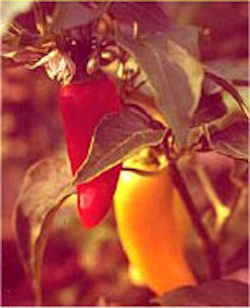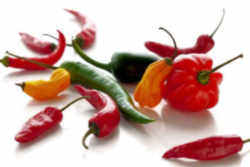
Texas Symbols
Texas State Pepper
Jalapeno

(Capsicum annum)
Adopted in May 10, 1995.
The jalapeño became the official state pepper of Texas when Governor George W. Bush signed House Concurrent Resolution No. 105 on May 10, 1995 by the 74th Legislature.
The US demand for jalapeños rises every year due to the popularity of Mexican and Tex Mex foods. On a hot pepper "heat index", the jalapeño is considered mild.
Texas ranked first in the production of jalapeño peppers nationwide in 2000.
Texas State Pepper: Jalapeno

The popularity of hot peppers has been growing since Columbus introduced them to the Americas. Within a century, hot chilies enhanced meals worldwide. The United State's demand for jalapeños keeps rising 50 to 20 percent a year due to the popularity of Mexican and Tex Mex foods. Americans' consumption of jalapeño-flavored tortilla and potatoe chips in 1991 came to 17 million pounds which makes this a valuable crop in Texas and the United States. The demand for this crop keeps increasing as grocery stores demand more jalapeños to stockpile on their shelves. Most Texas grown jalapeños end up in salsas or hot sauces. National sauce sales research showed that $674 million (41 million gal.) was produced in 1991, and Texas produced more than one-half of that.
In 1990 production went up after Dr. Villalon of Texas A & M introduced the TAM Mild jalapeño #1. This mildly pungent, multiple-virus resistant pepper was well suited to Texas. He later introduced a hotter jalapeño which adapted well to Texas. Statewide production of jalapeños keeps increasing but mainly in the Rio Grande Valley in South Texas, the Panhandle, and north of Loredo, Texas.
Why Chili Peppers are Hot?
A group of chemicals called CAPSAICINOIDS are responsible for the heat in chile peppers. Each one produces a slightly different burn. The hottest and most famous of the five is called capsaicin. This is one that produces the sensation of fire in your mouth. When the fire hits, your mouth sends a signal to your brain that signals the release of natural pain relievers, endorphins, which we all love. The amount of capsaicin in a hot pepper is expressed in Scoville Units.
Pepper Profile: Jalapeño
This chile was named after the city of Xalapa in Veracruz, Mexico, where it is no longer commercially grown.
Family: Solanaceae
Genus: Capsicum (KAP-sih-kum)
Species: annum (AN-yoo-um)
Species:
The category of biological classification ranking immediately below the genus (ie. Capsicum) which relates all organisms potentially capable of interbreeding. All domesticated chile peppers are classified into five species: C. annuun var. annuun, C. frutescens, C. chinense, C. baccatum var pendulum, and C. pubescens. There are many more wild species, only a few of them domesticated (i.e. chiltepin). Virtually all of the Capsicums found in markets around the world are C. annuum var annuum, although there exist many cultivars within this species.
The Plant
This chile pepper is a pod type of Capsicum annuum. Jalapeños usually grow from 2 1/2 to 3 feet tall. Jalapeños have a compact single stem or upright, multibranched, spreading habit. The leaves are light to dark green and measure about 3 inches long and 2 inches wide. The flower corollas are white with no spots. The pods, which are conical and cylindrical, are pendant and measure about 2 to 3 inches long and 1 inch wide. They are green (occasionally sunlight will cause purpling), maturing to red, and measure between 2,500 and 10,000 Scoville Units. The brown streaks, or "corking" on the pods are desirable in Mexico but not so in the US
Agriculture
In the United States, approximately 5,500 acres is under cultivation, with Texas the leading state for jalapeño production, followed by New Mexico. Home gardeners should remember that the US varieties of jalapeños flourish better in semi-arid climates--ones with dry air combined with irrigation. If planted in hot and humid zones in the US during the summer, the yield of such jalapenos decreases and so Mexican varieties should be grown. The growing period is 70 to 80 days, and the yield is about 25 to 35 pods per plant.
Culinary Usage
Jalapeños are one of the most famous chile peppers. They are instantly recognizable and a considerable mythology has sprung up about them, particularly
in Texas. The impetus for the popularity of jalapenos starts from a combination of their unique taste, their heat, and their continued use as a snack
food.
In 1956, Newsweek magazine published a story on a pepper-eating contest held in the Bayou Teche country of Louisiana, near the home of the famous Tabasco
sauce. The article rated the jalapeño as "the hottest pepper known," more fiery than the "green tabasco" or "red cayenne."
Thus the Tex-Mex chile was launched as the perfectly pungent pepper for jalapeño-eating contests, which have proliferated all over the country.
Texas House Concurrent Resolution 105,
Texas Legislature
GOVERNMENT CODE
CHAPTER 3101. STATE SYMBOLS
State Pepper
Jalapeno House Concurrent Resolution 105, 74th Legislature, Regular Session (1995)
CONCURRENT RESOLUTION
By Thompson
H.C.R. No. 105 74R4587 KMP-D
WHEREAS, The State of Texas has traditionally recognized a variety of official state symbols that embody the proud spirit and rich heritage of our
state; and
WHEREAS, The bluebonnet, the pecan tree, and the ruby red grapefruit are examples of natural specimens that serve to exemplify the abundance and diversity
of the Texas landscape; and
WHEREAS, In keeping with this custom, the designation of the jalapeno as the official State Pepper of Texas will provide suitable recognition for this
delicious and indispensable staple of Texas cuisine; and
WHEREAS, Capsicums, more commonly called peppers, provided nourishment for Native Americans in central Mexico as early as 9,000 years ago and, following
the voyage of Columbus to the Americas, became a popular addition to the diets of people throughout the world; and
WHEREAS, The most popular variety of capsicum, the jalapeno, is considered by many Lone Star denizens to be an essential ingredient in chili, our official
State Dish; found in salsa and queso, the ubiquitous jalapeno is used by Texans to add zest to even the most common American dishes, and many brave
souls have been known to consume the fiery foodstuff in its raw and pickled states; and
WHEREAS, In addition to pleasing Texas palates, jalapenos are an important agricultural crop in the Lone Star State, which leads the nation in jalapeno
production and consumption; these savory peppers are also a hot commodity in the national marketplace, with demand growing at an estimated 15 to 20
percent each year; and
WHEREAS, Jalapenos get their distinctive sting from capsaicin, a chemical used to treat arthritis, shingles, sore muscles, and nerve disorders and
believed by many researchers to be effective in the fight against cancer and heart disease; the remarkable health benefits of these small but potent
peppers are compounded by the fact that they contain as much vitamin A as carrots and more than twice the vitamin C of oranges and lemons; and
WHEREAS, A culinary, economic, and medical blessing to the citizens of the Lone Star State, the jalapeno is widely recognized as an emblem of our state
and is a distinctive reminder of our state's unique heritage and diverse culture; now, therefore, be it
RESOLVED, That the 74th Legislature of the State of Texas hereby designate the jalapeno as the official State Pepper of Texas.
House Concurrent Resolution No. 105, 74th Legislature, Regular Session (1995)
Texas Law
The jalapeno was named the official state pepper of Texas by House Concurrent Resolution and were not, therefore, listed in the Texas Statutes.
Taxonomic Hierarchy: Jalapeno
Kingdom: Plantae - Plants
Subkingdom: Tracheobionta - Vascular plants
Superdivision: Spermatophyta - Seed plants
Division: Magnoliophyta - Flowering plants
Class: Magnoliopsida - Dicotyledons
Subclass: Asteridae
Order: Solanales
Family: Solanaceae - Potato family
Genus: Capsicum L. - pepper
Species: Capsicum annuum L. - cayenne pepper

List Official US State Foods






